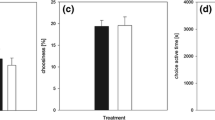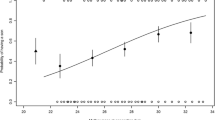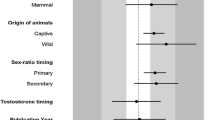Abstract
A number of recent reports have documented offspring sex ratio biases in birds. However, to date the potential mechanisms that have been put forward to explain the proximate basis for these deviations are entirely speculative. Using a captive population of domestic pigeons (Columba livia domestica), I tested the hypothesis that mothers in relatively poor physical condition should overproduce daughters by manipulating maternal body condition around the time of egg laying by continuous egg removal and differing feeding regimes. During treatment, females were fed a controlled quantity of food. This, combined with the high energetic costs of repeated egg production caused a significant reduction in maternal body weight. In contrast, during control when food was available ad libitum, maternal body weight did not decline, despite repeated egg production. No significant deviation from parity was evident in the sex ratio of either the first or second eggs during control, whereas during treatment a significant female bias was evident in not only the first egg, but also in the second egg. The absence of single-egg clutches, the rarity of infertile eggs and the lack of laying delays between eggs strongly suggests that the mechanism of sex ratio adjustment in pigeons occurs prior to ovulation. The highly skewed sex-distribution within the two-egg clutches and the unexpectedly large amount of variation in the yolk weight of eggs produced during treatment (but not control) are consistent with the expectations of pre-ovulatory selective resorption of ‘wrong’ sex ovarian follicles.




Similar content being viewed by others
References
Abs M (1983) The physiology and behaviour of the pigeon. Academic Press, London
Ankney CD (1982) Sex ratio varies with egg sequence in lesser snow geese. Auk 99:662–666
Arnold KE, Griffith SC, Goldizen AW (2001) Sex-biased hatching sequences in the cooperatively breeding Noisy Miner. J Avian Biol 32:219–223
Arnold KE, Orr KJ, Griffiths R (2003) Primary sex ratios in birds: problems with molecular sex identification of undeveloped eggs. Mol Ecol 12:3451–3458
Badyaev AV, Hill GE, Beck ML, Dervan AA, Duckworth RA, McGraw KJ, Nolan PM, Whittingham LA (2002) Sex-biased hatching order and adaptive population divergence in a passerine bird. Science 295:316–318
Bradbury RB, Blakey JK (1998) Diet, maternal condition, and offspring sex ratio in the zebra finch, Poephila guttata. Proc R Soc Lond B 265:895–899
Bruford MW, Hanotte O, Brookfield JFY, Burke T (1998) Multilocus and single-locus DNA fingerprinting. In: Hoelzel AR (ed) Molecular genetic analysis of populations: a practical approach, 2nd edn. IRL Press, Oxford, pp 287–336
Charnov EL (1982) Parent-offspring conflict over reproductive effort. Am Nat 119:736–737
Clout MN, Elliott GP, Robertson BC (2002) Effects of supplementary feeding on the offspring sex ratio of kakapo: a dilemma for the conservation of a polygynous parrot. Biol Conserv 107:13–18
Cockburn A, Legge S, Double MC (2002) Sex ratios in birds and mammals: can the hypotheses be disentangled? In: Hardy I (ed) The sex ratio handbook. Cambridge University Press, Cambridge
Edmunds SR, Ankney CD (1987) Sex ratios of hatchling mourning doves. Can J Zool 65:871–874
Emlen ST (1997) When mothers prefer daughters over sons. Trends Ecol Evol 12:291–292
Ewen JG, Cassey P, Moller AP (2004) Facultative primary sex ration variation: a lack of evidence in birds? Proc R Soc Lond B 271:1277–1282
Fiala KL (1981) Sex ratio constancy in the red-winged blackbird. Evolution 35:898–910
Fridolfsson AK, Ellegren H (1999) A simple and universal method for molecular sexing of non-ratite birds. J Avian Biol 30:116–121
Griffiths R, Double C, Orr K, Dawson R (1998) A DNA test to sex most birds. Mol Ecol 7:1071–1075
Hanson HC, Kosack CW (1963) The mourning dove in Illinois III. Dept. Conserv Tech Bull No. 4
Hawkins P, Morton DB, Cameron D, Cuthill I, Francis R, Freire R, Gosler A, Healy S, Hudson A, Inglis I, Kirkwood J, Lawton M, Monaghan P, Sherwin C, Townsend P (2001) Laboratory birds: refinements in husbandry and procedures. Lab Anim-UK 35:S1–S163
Heinsohn R, Legge S, Barry S (1997) Extreme bias in sex allocation in Eclectus parrots. Proc R Soc Lond B 264:1325–1329
Houston DC, Jones PJ, Sibley RM (1983) The effect of female body condition on egg-laying in lesser back backed gulls Larus fuscus. J Zool 200:509–520
Johnson AL, van Tienhoven A (1980) Plasma concentrations of six steroids and LH during the ovulatory cycle of the hen, Gallus domesticus. Biol Reprod 23:386–393
Johnston RF, Janiga M (1995) Feral pigeons. Oxford University Press, New York
Kalmbach E, Nager RG, Griffiths R, Furness RW (2001) Increased reproductive effort results in male-biased offspring sex ratio: an experimental study in a species with reversed sexual size dimorphism. Proc R Soc Lond B 268:2175–2179
Kilner R (1998) Primary and secondary sex ratio manipulation by zebra finches. Anim Behav 56:155–164
King JR (1973) Energetics of reproduction in birds. In: Farner DS (ed) Breeding biology of birds. National Academy of Sciences, Washington, D.C., pp 78–106
Komdeur J, Daan S, Tinbergen J, Mateman C (1997) Extreme adaptive modification in sex ratio of the Seychelles warbler’s eggs. Nature 385:522–525
Komduer J, Magrath MJL, Krackow S (2002) Pre-ovulation control of hatchling sex ratio in the Seychelles warbler. Proc R Soc Lond B 269:1067–1072
Kotov AA (1978) Data on the ecology and behaviour of the rock dove in the Southern Urals and Western Siberia. Byull Moskovsk O-va Isp Prirodi Otd Biol, 83:71–80
Krackow S (1995) Potential mechanism for sex ratio adjustment in mammals and birds. Biol Rev 70:225–241
Krackow S (1999) Avian sex ratio distortions: The myth of maternal control. In: Adams N, Slotow R (eds) 22nd International Ornithological Congress, vol. 1. Bird Life South Africa, Durban, pp 425–433
Levi WM (1945) The pigeon. Bryan, Columbia, S.C.
Monaghan P, Nager RG, Houston DC (1998) The price of eggs: increased investment in egg production reduces the offspring rearing capacity of parents. Proc R Soc Lond B 265:1731–1735
MacGregor WC (1958) Non-unisexual broods in the mourning dove. J Wildl Manage 22:103
Nager RG, Monaghan P, Griffiths R, Houston DC, Dawson R (1999) Experimental demonstration that offspring sex ratio varies with maternal condition. Proc Natl Acad Sci USA 96:570–573
Oddie K (1998) Sex discrimination before birth. Trends Ecol Evol 13:130–131
Pen I, Weissing FJ (2000) Optimal sex allocation: steps towards a mechanistic theory. In: Hardy I (ed) The sex ratio handbook. Cambridge University Press, Cambridge, pp 59–69
Petrie M, Schwabl H, Brande-Lavridsen N, Burke T (2001) Sex differences in avian yolk hormone levels. Nature 412:489
Pike TW, Petrie M (2003) Potential mechanisms of avian sex manipulation. Biol Rev 78:553–574
Riddle O (1917) The control of sex ratio. J Wash Acad Sci 7:319–356
Sheldon BC, Andersson S, Griffith SC, Ornborg J, Sendecka J (1999) Ultraviolet colour variation influences blue tit sex ratios. Nature 402:874–877
Sturkie PD (1986) Avian Physiology. Springer, Berlin Heildelberg New York
Teather KL (1987) Intersexual differences in food consumption by hand-reared great-tailed grackle (Quiscalus mexicanus) nestlings. Auk 104:635–639
Teather KL, Weatherhead PJ (1988) Sex-specific energy-requirements of great-tailed grackle (Quiscalus mexicanus) nestlings. J Anim Ecol 57:659–668
Veasey JS, Houston DC, Metcalfe NB (2001) A hidden cost of reproduction: the trade-off between clutch size and escape take-off speed in female zebra finches. J Anim Ecol 70:20–24
Whittingham LA, Dunn PO (2000) Offspring sex ratios in tree swallows: females in better condition produce more sons. Mol Ecol 9:1123–1129
Williams TD (1999) Parental and first generation effects of exogeneous 17β-estradiol on reproductive performance of female zebra finches (Taeniopygia guttata). Horm Behav 35:135–143
Wood-Gush DGM, Gilbert AB (1970) The rate of egg loss through internal laying. Br Poult Sci 11:161–163
Acknowledgements
I am grateful to the Biotechnology and Biological Sciences Research Council for financial support and to Marion Petrie and two anonymous referees for valuable comments which greatly improved the manuscript. The experiment outlined here complies with the current laws of the United Kingdom
Author information
Authors and Affiliations
Corresponding author
Additional information
Communicated by M. Leonard
Rights and permissions
About this article
Cite this article
Pike, T.W. Sex ratio manipulation in response to maternal condition in pigeons: evidence for pre-ovulatory follicle selection. Behav Ecol Sociobiol 58, 407–413 (2005). https://doi.org/10.1007/s00265-005-0931-9
Received:
Revised:
Accepted:
Published:
Issue Date:
DOI: https://doi.org/10.1007/s00265-005-0931-9




